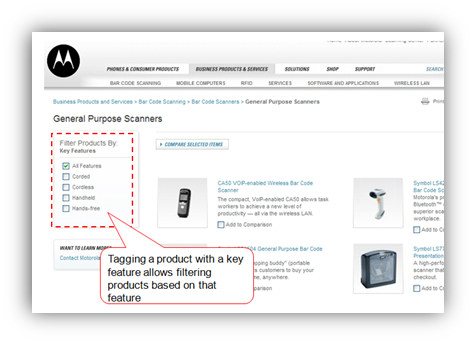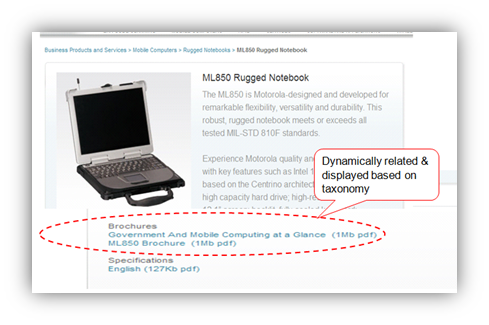Global Taxonomy & Content Management | Motorola
Challenge
Imagine deploying anything – an idea, tool, software or structure – accurately and consistently across 63 countries and in 23 languages. Now imagine that implementation was not one item but dozens of branded products and accessories with options and features that varied from country to country. To add to the complexity, imagine that, once implemented, customization was to be in the hands of the local marketing and technology experts in each geography.
“Our goal was to allow people from those 63 countries and 23 languages to manage their content and maintain it across multiple business units located globally.” reports Charlie Gray, Motorola Interactive Marketing, Manager of the Content Management Strategy and Implementation. Charlie was developing a content management system in one business unit of Motorola when he was offered the opportunity to roll out a global taxonomy and content management system across the corporation and to manage all of Motorola’s websites.
“A taxonomy gives you the ability to establish relationships which when implemented in a web experience allows the visitor to search for information in a variety of ways and presents related content automatically.” explains Charlie “The reason for a global taxonomy was to create a global content management system for all of Motorola’s public facing websites.” Although a taxonomy had previously been developed, Charlie knew that to be successful with a global implementation, it would need expansion and, more importantly, the Marketing community needed to understand how to apply the taxonomy and how to maintain it in the long run.

Solution
Charlie attended one of Seth Earley’s sessions at a prominent conference and was impressed with his talent for explaining a taxonomy, how it was used and why it was important. “He’s a dynamic and energetic speaker and I knew he could articulate the message to a business audience”. Charlie invited Seth to present at Motorola to the global interactive marketing organization.
The session was titled: “What is a Taxonomy and Why Should I Care?” The response to Seth’s presentation was terrific. He did a great presentation complete with compelling, relevant examples and visuals. By the end of the meeting, everyone understood the impact of not having a taxonomy on our websites. He showed the results of searching on the Motorola website using slight variations in terms and getting very different (and sometimes very humorous) results.
These examples crystallized the concept of taxonomy and drove home its importance to the marketing professionals. After the conference, Seth brought in his team of consultants and analyzed the existing taxonomy, business needs and global environment to draft a global taxonomy structure. Then the Earley team ran a series of workshops with the subject matter experts to amend and extend the draft taxonomy and recommend a global structure.
Attributes and facets were included that would be valuable not only to an e-commerce implementation but also to other possible applications in the future. This meant that the taxonomy was extended to be applicable to a wide range of systems and purposes at Motorola. The Earley team drew on many resources and created a customized series of Community of Practice Calls to broaden the understanding of taxonomies and content management across Motorola. During those calls individuals from other corporations shared their experiences with the taxonomy process. “Those calls were absolutely worthwhile.” exclaims Charlie “They help you realize that you are not alone in trying to do this stuff and it provides the opportunity to learn from best practices at other companies that Earley has worked with. Seth is very open with his knowledge and creates a learning and sharing environment that extends across the industry. Those calls helped create a vision of what Motorola should be able to achieve in the long term with this project. That's very important for an abstract concept like taxonomy that so many different uses in the organization.”
A core group from around the globe worked to implement the new taxonomy structure. They were careful to include the attributes of each product, where it would be sold, product specifications, markets, customer segments and accessories. “What that means on a website is that, with those relationships defined, the web visitor can actually find the exact products that are sold in their country, and also find all the accessories that work with that particular product.” Charlie explains.

Results
Motorola achieved the major goal of website consistency immediately. No longer were products displayed and compared differently. They were able to source their content to deliver consistent branding, messaging and compare capabilities. The savings from eliminating duplication of effort were also immediate. “Now, individual business units around the globe are working together not separately to solve these common business problems.” Says Charlie “It’s a huge cost avoidance. The savings are projected to be in the millions.” Charlie reports that tremendous synergies have also resulted from the implementation. Now when a product is rolled out, that same campaign can be used for messaging and branding and all the geographies have to do is customize it.
Discover Expert Insights
See the latest news in the information architecture space through our blog posts, whitepapers, webinars, and more.
